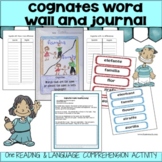We know that ESL instruction is an important part when we are trying to teach reading to ELs. I admit that it takes a bit of patience and creativity, but there are some simple tricks that work wonders. It's important to begin by introducing ESL learners to an all-encompassing approach to starting reading: the reading domain. This domain encompasses preparing ESL students, in listening comprehension, and written and oral skills.
As ESL teachers, it is our job to ensure we are giving ESL learners the best start possible in listening, reading, writing, and speaking. By establishing a quality learning environment and fostering relationships between teacher and student, ESL teachers have the power to make tremendous improvements in their ESL learner's reading abilities while also motivating them toward personal success. So let’s take a look at a few essential tips for teaching English learners to read.

I feel when teaching ESL and ELL students to read in English, it is important to start at the basic level. Providing them with training and instruction that focuses on the foundational reading skills such as:
phonological awareness
alphabetic understanding
print concepts
fluency

It may also involve other domains such as grammar and spelling rules, speaking or comprehension. It is also wise to create learning experiences that embrace unique cultures and accommodate different learning styles. Incorporating learning activities with visuals and other tangible resources can greatly assist ESL students in achieving their reading goals. Finally, providing frequent feedback and support will help ESL students retain what they have learned and stay motivated in their pursuit of mastering English language literacy.
Teach Reading to ELs - Start with the First Language
Building a solid foundation in their first language is the best place to start. Show students how certain grammatical are similar or different to their native language. This jumpstarts their reading when they can know which components are the same or different. It is an obvious first step when building an ESL student’s background knowledge. You can find grammatical comparisons online that will show you where to focus.

Teach Reading to ELs - Begin at the Beginning
It’s also crucial to be aware of the level of proficiency. For beginning and early intermediate speakers, we want to focus on listening comprehension. Students cannot learn phonics if they cannot hear the sounds. I like to start with sentence recognition and work down to word-by-word recognition and finally teach the sounds of the letter. Games are a great way to do this. I like to read fun stories and have the students jump up or raise a hand when they think a sentence ends and a new one begins. There are lots of ways to bring fun into developing listening comprehension.
Begin by creating a strong foundation in the reading domain and build upon that. Familiarize ESL and ELL students with common reading strategies:

recognizing words
breaking down sentences
how to use context clues to understand new vocabulary
Once ESL students have reached a reasonable level in English foundation skills like phonics, sequencing, and story mapping will help develop literacy as well - allowing ESL students to make personal connections with what they have heard and learn from context clues that may otherwise have gone unnoticed!
Teach Reading to ELs - Don’t Forget Phonics
Phonics instruction is essential for English learners. When teaching phonics, I focus on identifying the sounds and learning to associate them with written symbols or letters. This is critical for ESL students, as a knowledge of the language’s phonemes and graphemes is needed to learn how to read properly in the English language. Additionally, I help ESL students recognize syllabication patterns and correctly form words within a sentence structure; this serves to further support their growing understanding of how phonemes come together to shape written language in the English domain. Lastly, I also strive to reinforce my ESL instruction for English Learners through activities that involve listening comprehension and pronunciation practice, which can ultimately play an integral role in helping learners become adept readers of English.

Teach Reading to ELs - Build Vocabulary
The number one element emerging readers need is vocabulary development. This is especially important for ESL students. There are many ways to build vocabulary. Here are some of my favorite activities and games:
Semantic Gradients


Cognates
Verb Games
Academic Vocabulary
Teach Reading to ELs - Activities That Work
I regularly use activities like choral reading, dictations, and syllabication practice. Sounding out unknown words will help ELLs hear the structure of English. Additionally, I bring in interesting reading material to help engage ESL/ELL students in the learning process and make it fun for them. I spend a lot of time practicing letter and vowel sounds and syllabication as my Els learn to read. Encouraging ESL learners to practice by engaging in a range of daily activities is essential. These activities may include:
reading out loud from books or magazines
playing word games
discussing topics related to current events
With regular practice and exposure to different types of texts, ESL learners can develop the ability to read in English skillfully.
When teaching ESL or English Learners how to read in English, it's important to start with the basics. Offer explicit instruction DAILY. Repeated practice of the skills being taught will build a strong reading foundation. English learners need to practice these skills within a variety of contexts, both inside and outside the classroom. Lastly, create an encouraging learning environment where each English Learner feels comfortable asking questions or seeking additional help if needed.



No comments:
Post a Comment